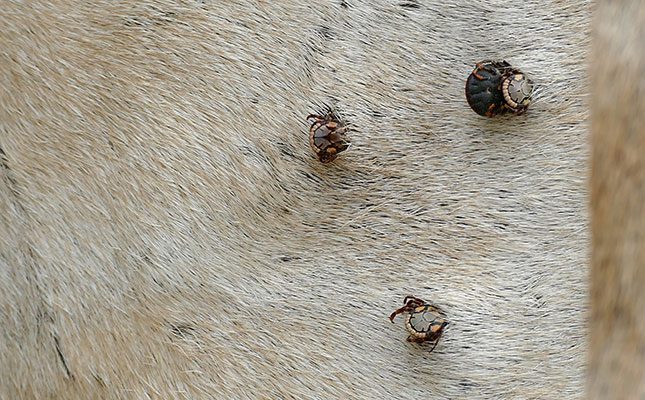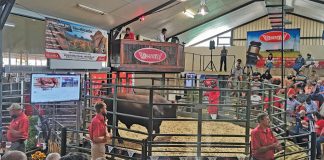
Photo: Wikimedia Commons
There are nearly 900 species of tick in the world, and while they differ from species to species, they have one thing in common: they are bloodsucking arachnids.
There are two ‘types’: hard ticks and soft ticks. However, they are somewhat similar in appearance: they are relatively flat when not engorged, are not segmented, and have four pairs of legs. Each leg is covered in short, spiny hairs and has a claw at the end. This helps the tick grasp blades of grass and leaves, as well as holding on to their hosts.
The tick feeds by attaching to the host with its mouthparts. It has two chelicerae, which pierce the host’s skin. The two palps move out of the way during feeding, and the hypostome is a needle-like part that ‘injects’ into the host to feed. The hypostome is barbed.
These barbs point back towards the tick, which is why it is difficult to remove an attached tick without damaging the host’s skin. The saliva secreted by the tick during feeding also acts like a cement, making it even more difficult to remove the tick from the host.
As the tick feeds, its body becomes engorged and it swells. Soft ticks do not swell as much as hard ticks, and female hard ticks tend to swell more than their male counterparts, as they store more blood for laying eggs. Male hard ticks swell very little, as the conscutum constricts swelling.
Bont ticks
Amblyomma hebraeum, known as the South African bont tick, is distributed across the country, and is particularly prevalent along the coastal belt from Gqeberha in the Eastern Cape through KwaZulu-Natal and across Mpumalanga, Gauteng, Limpopo and North West.
It is also present in eastern Eswatini, southern Mozambique, eastern Botswana and in southern and eastern Zimbabwe. A. hebraeum is a three-host tick.
The adults and nymphs ‘hunt’ for their next host by ‘scuttling’ across the ground and attaching to the host. Once the female adult is engorged, she detaches and can lay up to 20 000 eggs.
These hatch after two to three weeks if the weather conditions are favourable. Once acceptable hosts, including cattle, sheep and goats, begin grazing, the larvae attach to the host, and become engorged in seven to 14 days. They then detach and moult. The nymphs also engorge within one to two weeks, detach and moult. Adult males will then attach to a host, and begin engorging.
Male ticks that have been engorging for around six days become sexually mature. Only when sexually mature adult males are attached to the host, will female adults attach. The pheromones secreted by the sexually mature adult males also attract more male ticks and nymphs, which leads to greater infestation of the host.
After mating, the female engorges for around seven days, before detaching. Male ticks can remain on the host for two to four months, and the whole life cycle lasts around 12 months.
Adult and immature A. hebraeum feed on cattle, sheep, goats and large wild ruminants, such as giraffes, African buffalo, eland, and white and black rhinoceroses. Immature ticks, however, also feed on small antelope, scrub hares, helmeted guineafowl and tortoises.
The bont tick likes moisture and warmth, and brush and bush.
It does not survive in the open grassland. This tick is responsible for transmitting heartwater to livestock, as well as Rickettsia africae and benign bovine theileriosis. It’s also responsible for African tick bite fever in humans.
How to spot bont ticks
The bont tick is of a medium or large size. It has long mouthparts, and is probably best recognisable by its banded legs. Its eyes are flat, and the conscutum of the adult male tick is ornate, with two discrete lateral patches of colour. The first festoon on either side is yellow. The bont tick closely resembles A. gemma, an East African tick.
As the adult A. hebraeum prefers feeding on hairless areas of an animal, look for this tick under the animal’s tail, in the lower perineal region, on the udder and testes, around the prepuce and axilla of cattle, and around the feet of sheep and goats. Larvae can be found on the feet, legs and muzzle of the animal, while nymphs attach to the feet, legs, groin, sternum and neck.
Large bont-legged tick
Hyalomma rufipes is better known as the large bont-legged tick. It is prevalent throughout South Africa, with the exception of the eastern Free State, and the coastal areas of KwaZulu-Natal and the Western Cape. It is also widespread in Botswana, Zimbabwe and northern Namibia, as well as in Kenya, Ethiopia and Somalia and the southern countries of West Africa.
The large bont-legged tick feeds on cattle, sheep, goats, horses and rhinoceroses, amongst others. The immature ticks also feed on scrub hares and birds such as the guineafowl. H. rufipes is a two-host tick, and the adult ticks are hunters. The mature female engorges for seven to 14 days before detaching from the host. It then lays 2 000 to 10 000 eggs and dies.
The larvae hatch in a month or two. The larvae then attach to scrub hares or ground-frequenting birds, where they engorge and moult to nymphs. The nymphs detach and moult into adults. As with the bont tick, the life cycle of the large bont-legged tick lasts around one year.
In South Africa, this tick is mainly active from October to March. However, immature ticks may also be active during autumn and spring.
The tick’s large mouthparts can cause damage to the skin of the host, and the introduction of secondary bacterial infections may lead to abscesses. It can also cause lameness in lambs, and transmits the pathogens responsible for bovine anaplasmosis, gallsickness and benign babesiosis in cattle.
How to spot the large bont-legged tick
The adult male has a conscutum that is dark brown to nearly black. The tick is broadly oval, and its entire surface is covered with medium-sized, coarse punctations. The brown legs are brightly banded with ivory-coloured rings.
The adanal plates have square ends, and the sub-anal plates are distinct but small and aligned with the adanal plates. The genital apron of the female is convex, and the genital aperture is broadly V-shaped.
As adults attach to the hairless area of cattle, look for this tick around the animal’s anus and on its genitalia. It can also be found around the hooves of sheep.
The immature stages are found on the necks of scrub hares and on the heads and necks of birds.
Smooth bont-legged tick
Hyalomma truncatum (smooth bont-legged tick) is present throughout South Africa, with the exception of the Eastern Cape, the eastern half of the Free State, south-eastern Gauteng, south-eastern Mpumalanga and southern KwaZulu-Natal. It is also present throughout Zimbabwe and much of Mozambique, as well as Botswana, Namibia and southern Angola.
The smooth bont-legged tick feeds on cattle, sheep, goats, horses, rhinoceros, giraffe and dogs. In the immature stages, the ticks also feed on scrub hares and various species of small rodents, such as bushveld gerbils.
H. truncatum is a two-host tick. The adults are hunters. The female ticks engorge for seven to 14 days and then detach. They lay between 2 000 and 10 000 eggs before dying.
The larvae hatch in 30 to 60 days and infest hares and rodents, on which they engorge and moult to nymphs. The engorged nymphs detach, drop to the ground and moult to adults.
The life cycle takes a year to complete.
Certain strains of H. truncatum contain a toxin in their saliva that causes sweating sickness, an acute dermatitis in cattle, particularly calves. The tick’s long mouthparts cause tissue damage in cattle and sheep and secondary bacterial infections may lead to abscess formation. The tick also causes lameness in lambs.
Spotting the smooth bont-legged tick
The conscutum of the adult male is dark brown, and is fairly narrow and glossy. The legs are brown and brightly banded with ivory-coloured rings. The adanal plates have square ends, and the sub-anal plates are distinct but small and aligned with the adanal plates.
The genital apron of the female is concave. Look for this tick on the tail switch of cattle, around the anus, on the lower perineum and on the legs. They are also found around the hooves of sheep. The immature stages attach on the necks of scrub hares.
Sources: Madder, M et al. ‘Ticks of Veterinary Importance/Differential Diagnosis (n.d.); Ticksafety.com, ‘Tick anatomy 101’ (n.d.).











